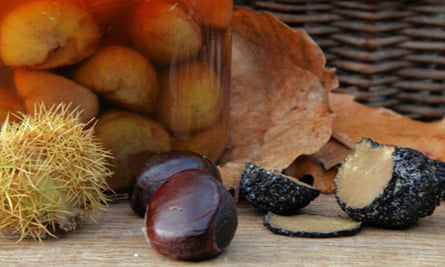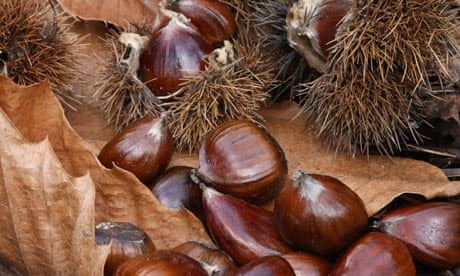Sweet chestnuts, either native or imported, are scandalously under-appreciated by the British. As the 17th century writer and gardener Evelyn laments: "But we give that fruit to our swine in England, which is amongst the delicacies of princes in other countries". Take chestnut flour; it's useful for making chestnut macaroons, florentines and, since it adds flavour instead of taking it away as flour tends to do, I use it in a roux when making sauces and soups.
Chestnut trees grow very well - and very large - in Britain but their crop of nuts is almost invariably disappointing. Most of the husks contain tiny wafers of empty skins and even the occasional decent sized nut is a third the size of its south European sisters. In mid to late October I can still be distracted from my many fungus forays by the sight of chestnuts on the forest floor. On a good day I can fill a couple of pockets, but mostly it will take a week to find enough to do anything with.
And what to do with it? You can make a chestnut beer – a boon to those unfortunate enough to be intolerant of gluten. Like all beers, however, it takes time and effort. Much simpler and quicker is a chestnut liqueur – in this instance I used large imported ones – 30 of which are easier to peel than 100 tiny native specimens.

500g chestnuts (when peeled)
150g sugar
200ml water
500ml brandy
Peeling chestnuts is one of those things that are good for your karma if you can get through the process without throwing things at the wall. The minimum requirement is a long radio play to keep you sane while you are doing it.
Boil the chestnuts in plenty of water in two equal batches for 20 minutes. Take the first batch off the heat and leave them in the water to keep them hot. Don a rubber glove and remove one chestnut. Make a cut two thirds of the way around the flat face of the skin and peel it away then ease the rest of the nut out of the skin. If the chestnuts are fresh both the outer and the more troublesome inner skin will come away at the same time. Boil and peel the second batch.
Place the nuts in a wide saucepan and cook very gently in 200ml of water for another 10 minutes with the lid on and without stirring. Carefully remove the nuts and stir in the sugar until dissolved. Return the nuts to the pan and cook gently with the lid off for another five. Place the nuts in a Kilner jar, add the liquor via a fine sieve then add the brandy.
Mine has been left for two weeks now and the flavour of the chestnuts is coming through nicely. The liqueur itself is a bit on the murky side but I can live with this, especially as it is used mostly in mixes. The chestnuts themselves taste rather splendid and you can take them out and eat them after a few weeks.
There is one fitting but (very) optional extra which I added to my liqueur - truffle. I recently tried chocolate truffles with real white truffle (not to be confused with ganache-centred chocolates) and a truffle honey concoction and the experience has prompted me to add a couple of slices to my jar.

Comments (…)
Sign in or create your Guardian account to join the discussion